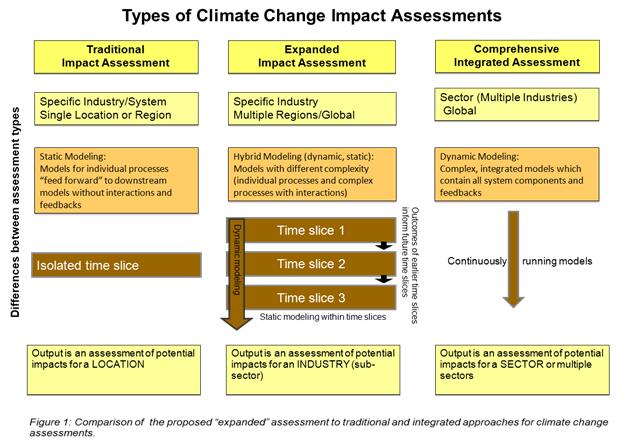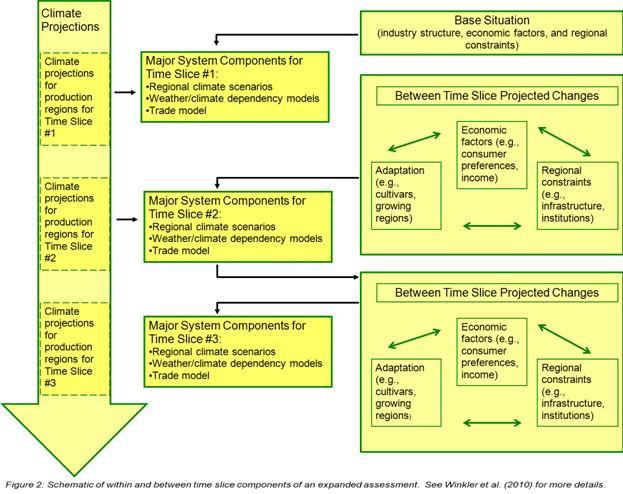

The project goals are to
1) advance our understanding of the potential impacts of climate variability and change on worldwide activities and systems,
2) improve methodologies for the assessment of climate change impacts, adaptation and vulnerability,
3) improve the characterizations of past, current, and future climates,
4) incorporate individual decision-making and adaptation into assessment processes, and
5) provide a novel approach for evaluating the overall uncertainty, or "meta-uncertainty," of assessment outcomes.
The primary project outcome is an integrated framework for climate change assessments of international market systems, especially industries with long-term investments. Because of our choice of example industry, a secondary outcome is a better understanding of the potential impacts of climate change on agriculture, specifically on specialized agriculture. With few exceptions, specialized agriculture has largely been ignored in the climate change literature, even though impacts are likely to be complex, especially for perennial crops, and specialized agriculture is often a locally or regionally important economic activity.

The vast majority of previous assessments of climate change impact, adaptation and vulnerability have focused on how a local/regional process or system may be impacted by a perturbed climate. For local/regional-scale assessments (often referred to as "traditional" assessments), models of the weather/climate dependency for a relevant process or activity are usually based on relationships observed for the current climate. The weather/climate dependency models are then used in combination with climate scenarios to project future changes. Traditional assessments rarely consider interactions between different geographic regions. Also economic impacts usually are not explicitly considered but rather roughly estimated from projected changes in productivity or user activity. In general, traditional assessments have employed static modeling that does not consider the evolution in time of system components (e.g. climate, other biophysical factors, economic impacts, decision-making, policy formulation) or interactions between components. Furthermore, the assessments are usually limited to a current (or control) period and a small number (one or two) of future periods typically separated by multiple decades. If more than one future period is included, the modeling activities for the later periods are rarely if ever informed by the modeling from the earlier periods. Instead, the future periods are treated independently. Thus, traditional assessments provide a high level of detail at one point in time, or a "snapshot" of potential impact. The characteristics of the traditional approach to impact assessment are summarized in the left-hand column of Figure 1. On the other side of the spectrum (depicted in the right-hand column of Figure 1) are comprehensive integrated assessments that focus on a sector, or even multiple sectors, of the economy. Ideally, this approach employs a complex, dynamic model running continuously in time that simulates the different components of a system (both physical and socioeconomic) and allows for feedbacks between system components, although current integrated assessment models have relatively simple characterizations for some if not all of the system components.

Neither approach is appropriate for a sub-sectoral (i.e., industry wide) assessment of the potential impacts of climate change. International market systems, by definition, are characterized by multiple production regions that are distributed worldwide and likely to be differentially impacted by climate change. Thus, assessments for specific industries require explicit, detailed representations of the weather/climate dependency of the industry and fine-scale comprehensive scenarios of future climate. In addition, sub-sectoral assessments need to include stakeholder decision-making more explicitly than in larger-scale sectoral assessments, as individual decisions heavily influence production and industry activity for future periods. Economic considerations are also extremely important in sub-sectoral assessments, and linkages between production regions via international trade need to be realistically incorporated into an industry-wide assessment. Given these demanding requirements it is not surprising that few sub-sectoral assessments have been attempted to date.
We have outlined a conceptual framework for undertaking industry-wide climate change impact assessments. This framework allows for dynamic, continuous modeling for those system components where this is possible and uses a time slice approach with static modeling for those components where dynamic modeling is not feasible (central column of Figure 1, Figure 2). Within a time slice, a chain of linked models is used to assess the potential impact of a changing climate on the market system, and succeeding time slices are connected by projections in adaptation options, economic factors such as consumer preferences, and regional development patterns. The rationale for this proposed framework is that while dynamic modeling is possible for climate projections, and possibly, depending on the industry, for estimation of the weather and climate impact on production potential, dynamic modeling is much more difficult for economic components of a system as current dynamic models are either overly abstract or the modeling effort requires abundant resources usually not available for impact assessments. In addition, the use of linked models within a time slice allows detailed, industry-specific modeling to be incorporated into the assessment process compared to the more generalized models used in most sectoral representations. The chain of linked models would include climate projections, models of the dependency of production or industry activity on weather and climate, and models of flows, trade, and individual decision-making under conditions of uncertainty including the evaluation of adaptation options. Selection and/or development of the individual models are interdependent activities as the level of detail required by "downstream" models informs the scale considerations and development of "upstream" models. The length of the time slice and the separation between time slices for the expanded framework is industry specific and reflects, among other factors, the expected degree of variability in climate, production, and the lifetime of an investment. An important and necessary component of the framework is that modeling within each time slice is informed by the changes observed in the previous time slice and expectations of the future.
More information on the conceptual framework can be found in: Winkler, J.A., S. Thornsbury, M. Artavio, F.-M. Chmielewski, D. Kirschke, S. Lee, M. Liszewska, S. Loveridge, P.-N. Tan, S. Zhong, J.A. Andresen, J.R. Black, R. Kurlus, D. Nizalov, N. Olynk, Z. Ustrnul, C. Zavalloni, J.M. Bisanz, G. Bujdoso, L. Fusina, Y. Henniges, P. Hilsendegen, K. Lar, L. Malarzewski, T. Moeller, R. Murmylo, T. Niedzwiedz, O. Nizalova, H. Prawiranata, N. Rothwell, J. van Ravensway, H. von Witzke, and M. Woods, 2010: Multi-regional climate change assessments for international market systems with long-term investments: A conceptual framework. Climatic Change, DOI 10.1007/s10584-009-9781-1.


The international tart cherry industry will be used as a "proof of concept" of the assessment framework. This industry was chosen as it is
1) is highly sensitive to climate extremes and threshold events,
2) is small enough in size and scope that it is possible to build a research team that is familiar with the different industry components and production regions,
3) reflects the challenges encountered by, and limited adaptation strategies of, any industry including non-agricultural commodities that have long planning horizons and long-term investments,
4) currently is undergoing a substantial evolution in terms of production and market regions,
5) previously has been the subject of intensive efforts by project team members to understand the impacts of weather and climate at the local/regional level, and
6) while small relative to total agricultural output for any of the production areas the tart cherry industry has a critical role at the local level.
Tart cherries are a perennial crop, requiring long-term investments by the producer. Returns are not realized until 3-6 years after initial investments and capital recovery can take as long as 25-years. The majority of exchange is in processed (e.g., frozen) products allowing for accumulation of storage. Ninety percent of the world production is concentrated in only nine countries. Major tart cherry growing regions include North America (primarily the state of Michigan in the United States) and central Europe (primarily Germany, Poland, and Hungary). Although varieties in these growing regions are somewhat similar, they are not perfect substitutes for each other given differences such as taste, color, and size. In worldwide exchange, Germany is the main consumer of tart cherries, and Poland is the primary international supplier to all markets. The tart cherry industry in the various countries is at very different stages of development which allows comparison of regional impacts across systems. The German and United States industries can be considered mature with a structure representative of much of agriculture in the developed world (more concentrated production with increasing pressure from new competitors). In contrast, the Polish and Hungarian tart cherry industries are developing rapidly. Other regions are potentially important producers. In particular, the tart cherry producers in the traditional producing areas within Europe are closely watching production changes in other areas of central and eastern Europe.
Previous assessments of potential impacts on climate change on regional tart cherry production include the recently-completed Pileus Project (www.pileus.msu.edu) at Michigan State University that developed decision support tools for growers in the tart cherry producing regions of Michigan to allow growers to evaluate the relative impact of climate, both historical variations and potential future change, on yield and the cascading impact on farm income. The KLIO project, led by Humboldt University in Berlin, investigated the risk involved in fruit production for four production areas in Germany as dependent on climate variability and change, along with the development of adaptive strategies.

Local-scale climate change scenarios of daily surface variables (e.g., temperature and precipitation) are being derived for the tart cherry production areas in Michigan and central and eastern Europe. A hybrid downscaling approach (illustrated below) using empirical functions translates the "intermediate" scale output from regional climate models (RCMs) driven by global climate models (GCMs) to the local scale. The empirical approach guarantees that scenarios at a local scale are available, and, by starting with the finer-scale RCM output, it is more likely that the impacts of regional-scale circulation on the local climate parameters are captured. Goals for this component of the project are to
1) identify effective and efficient strategies for acquiring, evaluating, validating, supplementing, and downscaling future climate scenarios for multiple regions at fine time and space scales,
2) evaluate the differences between central North America and central and eastern Europe in the performance of climate models and downscaling procedures, and
3) estimate the differences in the frequency of climate extremes (historically and for the future) of relevance to the example industry.
 Steps in construction of climate change scenarios.
Steps in construction of climate change scenarios.

Weather/dependency models link the climate scenarios with the economic components of the proposed framework. As weather/climate dependency models are highly industry specific, the goals of this component of the project primarily relate to the example industry and include:
1) the development of a physically-based yield model for tart cherries,
2) an evaluation of the representativeness of phenology and yield models between diverse growing regions, and
3) the incorporation of landscape variability in microclimate into productivity estimates.
We are employing a two-step, physically-based modeling approach to quantify the effect of weather and climate variability on tart cherry production in historical and projected future time frames. In the first step, crop phenology is estimated, as many of the relevant production impacts are dependent on the stage of crop growth and development. We are utilizing a simulation model for determining flower bud phenological stages and fruit growth as a function of daily maximum and minimum temperatures that was developed by as part of the Pileus Project for the most prevalent tart cherry variety grown in the United States. This model is being modified to estimate phenology in perturbed climates and for the application to European cultivars. Next, weather-dependent models of tart cherry yield will be developed for each of the five production areas (Michigan, Germany, Poland, Hungary, Ukraine) based on an existing scheme which relates yield to three major factors: cold/freeze injury to flower buds during dormancy and the early growing season, inclement weather during the pollination stage, and the amount of total precipitation just prior to senescence during the previous growing season. All of these weather-related factors are associated with specific growth or development stages of tree development. The output of the yield function is time series of estimated yield across historical and projected future time periods for each of the five production regions.

For the economics component, the central research goals are to
1) develop novel approaches to identify and evaluate alternative adaptation strategies to potential climate change such as research and development, modifications of existing technology or systems, or investments in existing but currently not economically feasible systems, and
2) incorporate productivity outcomes from models of individual decision-making into an international trade model.
The starting point of this portion of the research is a model of individual decision-making which incorporates adaptation options (including no change). Output is then linked to a multi-region model of production and consumption where decisions made in one region have implications for markets in other regions. Using an iterative approach, model outcomes (e.g., price, quantities traded) provide information for decision-makers on expected economic conditions for future time slices. Unique contributions of the include:
1) more explicit incorporation of uncertainties faced by individual decision-makers when considering adaptation strategies;
2) inclusion of the impacts of volume requirements and available infrastructure within a region on adaptation selections over time;
3) identification of tractable processes for upscaling site-specific climate, productivity, and individual decision-making for region-wide aggregation needed in a global assessment; and
4) expansion of economic assessments for sub-sectors that are particularly susceptible to climate change to include considerations of long-term investments and large sunk costs.
A production function approach is being utilized with a decision rule framework to evaluate different adaptation strategies and a real options model to link productivity projections (cherry yields) with market equilibrium generated from decision-making across a set of adaptation options. A key feature is the emphasis on heterogeneity in probability distributions and adaptation options across regions and across growers within the same region. The probabilities and adaptation options also change across different time slices. For each region, the adaptation options considered include one that requires longer-run research and development and at least two existing, but not currently adopted, technology/systems management options
Results from the decision-making models are incorporated into a partial equilibrium multi-region market model to capture feedbacks between the aggregated regional climate impacts on industry output and international market adjustments. The model is comparative static (i.e., non-dynamic) within the time slices but adjustment of macroeconomic variables (consistent with the emissions scenarios used in the climate projections) occurs between time slices. A partial equilibrium approach was chosen because the prototype industry is small in terms of worldwide economic impact and confined to a few countries.

Estimating, characterizing, and communicating uncertainty associated with a climate change assessment are challenging undertakings, in part because of the many possible uncertainty sources but also because of disciplinary differences in terminology and emphasis. Here we differentiate between two broad categories of uncertainty: 1) calibration error such as error introduced by the short period of observations available to calibrate a model, and 2) model structure error arising from how a model is formulated such as what terms are included. Whereas assessment studies frequently consider calibration error, at least for a subset of the models used in the assessment, model structural error is typically only considered for the climate component. We are evaluating the "meta-uncertainty" of the proposed linked model framework in addition to calibration error analyses for individual models. By meta-uncertainty, we refer to the aggregated uncertainty due to differences in the functional form, or structure, of the suite of linked models. We are building an ensemble of outcomes (price, quantity of product produced, and trade amounts for the different production regions) from the linked climate, yield, and economic models. The ensemble members reflect different combinations of alternative model structures. The proposed approach reflects what users of impact assessment would find useful, as the emphasis is on the uncertainty of the "final" outcomes rather than on individual components of the assessment.